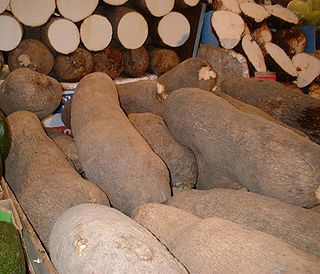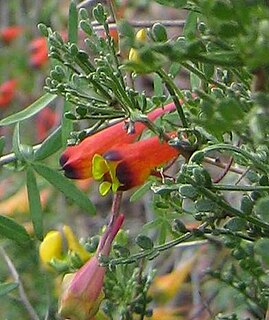
Dahlia is a genus of bushy, tuberous, herbaceous perennial plants native to Mexico and Central America. A member of the Compositae family of dicotyledonous plants, its garden relatives thus include the sunflower, daisy, chrysanthemum, and zinnia. There are 49 species of this genus, with hybrids commonly grown as garden plants. Flower forms are variable, with one head per stem; these can be as small as 5 cm (2 in) diameter or up to 30 cm (1 ft). This great variety results from dahlias being octoploids—that is, they have eight sets of homologous chromosomes, whereas most plants have only two. In addition, dahlias also contain many transposons—genetic pieces that move from place to place upon an allele—which contributes to their manifesting such great diversity.

'Bishop of Llandaff' is a cultivar of the dahlia, a garden plant. It is a branching, tuberous tender perennial with dark purple, almost black, foliage. This produces a stunning contrast with its scarlet flowers. The plant was first bred by Fred Treseder, a Cardiff nurseryman. It was selected by and named to honour Joshua Pritchard Hughes, Bishop of Llandaff, in 1924 and won the RHS Award of Garden Merit in 1928. The plant is about 1 m tall and flowers from June until September. As with all dahlias, frost blackens its foliage, and in areas prone to frost its tubers need to be overwintered in a dry, frost-free place.

Tubers are a type of enlarged structure used as storage organs for nutrients in some plants. They are used for the plant's perennation, to provide energy and nutrients for regrowth during the next growing season, and as a means of asexual reproduction. Stem tubers form thickened rhizomes or stolons ; well known species with stem tubers include the potato and yam. Some writers also treat modified lateral roots under the definition; these are found in sweet potatoes, cassava, and dahlias.

Cyclamen is a genus of 23 species of perennial flowering plants in the family Primulaceae. Cyclamen species are native to Europe and the Mediterranean Basin east to the Caucasus and Iran, with one species in Somalia. They grow from tubers and are valued for their flowers with upswept petals and variably patterned leaves.

A perennial plant or simply perennial is a plant that lives more than two years. The term is often used to differentiate a plant from shorter-lived annuals and biennials. The term is also widely used to distinguish plants with little or no woody growth from trees and shrubs, which are also technically perennials.

Nephrolepis exaltata, known as the sword fern or Boston fern, is a species of fern in the family Lomariopsidaceae. It is native to the Americas. This evergreen plant can reach as high as 40–90 centimetres (16–35 in), and in extreme cases up to 1.5 metres. It is also known as the Boston swordfern, wild Boston fern, Boston Blue Bell Fern, tuber ladder fern, or fishbone fern.

The Award of Garden Merit (AGM) is a long-established annual award for plants by the British Royal Horticultural Society (RHS). It is based on assessment of the plants' performance under UK growing conditions.

Pachyrhizus erosus, commonly known as jícamaMexican turnip, is the name of a native Mexican vine, although the name most commonly refers to the plant's edible tuberous root. Jícama is a species in the Pachyrhizus erosus in the pea family. (Fabaceae). Pachyrhizus tuberosus and Pachyrhizus ahipa are the other two cultivated species. The naming of this group of edible plants can sometimes be confusing, with much overlap of similar or the same common names.

Yam is the common name for some plant species in the genus Dioscorea that form edible tubers. Yams are perennial herbaceous vines cultivated for the consumption of their starchy tubers in many temperate and tropical regions, especially in West Africa, South America and the Caribbean, Asia, and Oceania. The tubers themselves, also called "yams", come in a variety of forms owing to numerous cultivars and related species.

In horticulture, bedding is temporary planting of fast-growing plants into flower beds to create colourful displays, during spring, summer or winter. Plants used for bedding are generally annuals, biennials or tender perennials; succulents are gaining in popularity.

Ornamental bulbous plants, often called ornamental bulbs or just bulbs in gardening and horticulture, are herbaceous perennials grown for ornamental purposes, which have underground or near ground storage organs. Botanists distinguish between true bulbs, corms, rhizomes, tubers and tuberous roots, any of which may be termed "bulbs" in horticulture. Bulb species usually lose their upper parts during adverse conditions such as summer drought and heat or winter cold. The bulb's storage organs contain moisture and nutrients that are used to survive these adverse conditions in a dormant state. When conditions become favourable the reserves sustain a new growth cycle. In addition, bulbs permit vegetative or asexual multiplication in these species. Ornamental bulbs are used in parks and gardens and as cut flowers.

Dahlia imperialis, or bell tree dahlia, is a large flowering plant, of the family Asteraceae, growing between 8–10 metres tall. It is native to Mexico, Belize, Guatemala, Honduras, El Salvador, Nicaragua, Costa Rica, Panama and south into Colombia and Ecuador. It is a plant of the uplands, mainly found in the foothills of subtropical or tropical mountains, at elevations around 1,500–1,700 metres (4,900–5,600 ft).

Tropaeolum tricolor, the three-coloured Indian cress or Chilean nasturtium, is a species of perennial plant in the family Tropaeolaceae. It is endemic to Chile, where it is called soldadito rojo and relicario.

Dahlia Hill (DH) is both a protected garden area in the Lower Peninsula of Michigan, encompassing 1.41 acres (0.57 ha) of terraced gardens, and the a 501(c)(3) non-profit educational organization that runs the garden. Located in the city of Midland, Michigan, they annually grow more than 3,000 dahlia plants.
The sweet potato is a very important crop for subsistence farmers in Africa and other developing countries. Its relatively short growing period, tolerance to drought and high yield from poor soils lead to its use as a famine reserve for many of these households. However, it is a highly perishable food source that is susceptible to destruction by microorganisms, metabolic spoilage, physical destruction and pests. Therefore, it is not generally stored for long after harvest. This is a major barrier for the optimal use of the crop and causes much waste.
The Plant Variety Protection Act of 1970 (PVPA), 7 U.S.C. §§ 2321-2582, is an intellectual property statute in the United States. The PVPA gives breeders up to 25 years of exclusive control over new, distinct, uniform, and stable sexually reproduced or tuber propagated plant varieties. A major expression of plant breeders' rights in the United States, the PVPA grants protection similar to that available through patents, but these legal schemes differ in critical respects. The PVPA should not be confused with plant patents, which are limited to asexually reproduced plants.

Dahlia pinnata is a species in the genus Dahlia, family Asteraceae, with the common name garden dahlia. It is the type species of the genus and is widely cultivated.
















